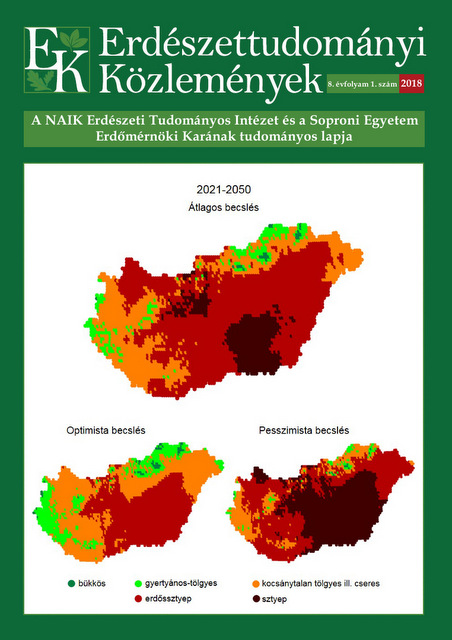Predicting the climate change induced yield potential changes of sessile oak stands
Gábor Illés
Correspondence
Correspondence: Illés Gábor
Postal address: H-9600 Sárvár, Várkerület 30/A.
e-mail: illes.gabor[at]erti.naik.hu
Abstract
Growth of forest stands is a central question in the field of forest research. Climate change impact assessment also assigns significance to this question. The growing conditions of forests are changing in Central Europe and the impacts of changes are generally considered to be disadvantageous. Increasing frequencies and duration of heat waves and droughts constrain the growing potential of industrially important species. For this reason a statistical evaluation of growth of sessile oak (Quercus petraea, Liebl) was conducted using site (bioclimate and soil) describing predictor variables. The study involved 4594 geo-referenced species records from the National Forestry Database. We focused on practically monoculture stands of seed origin. Climate variables were represented by the Climate EU database. The period of 1961-1990 was considered as climatic baseline. The future, altered climate conditions were represented by the RCP 4.5 scenario based climate models for the period of 2041-2070. Soil and non-climate site data were added from the most recent spatial soil database of Hungary. The statistical random forest package of R was used to build classifiers for yield class predictions based on soil and bioclimatic variables for the reference period. The results of the model series were tested on test sites taken from the permanent yield monitoring plots and forestry database. It was found that predictions reached a relatively high 62-83% correct classification rates by yield classes performing on 77% as an average. Models were run using future climate datasets for the period of 2041-2070 in order to assess changes in future yield classes of forests. Results showed that the extent of the area of best yield classes will decrease, and the most suitable areas show a slight shift to west and to north. In the Pre-Alps region, in the South-Transdanubian region, and in the Transdanubian Mountainous region the well growing sessile oak areas will probably turn into medium or even poorly growing ones. In the same time in the Northern Mountainous region models did not predict significant changes in yield potentials. Overall growing conditions of sessile oak seem to be slightly worsening in the next decades.
Keywords: forest growth, yield assessment, climate change, multivariate statistics
Open Acces
For non-commercial purposes, let others distribute and copy the article, and include in a collective work, as long as they cite the author(s) and the journal, and provided they do not alter or modify the article.
Cite this article as:
Illés, G. (2018): Predicting the climate change induced yield potential changes of sessile oak stands. Bulletin of Forestry Science, 8(1): 105-118. (in Hungarian) DOI: 10.17164/EK.2018.007
Volume 8, Issue 1
Pages: 105-118
First published:
29 May 2018
Related content
13
More articles
by this authors
7
Related content in the Bulletin of Forestry Science*
More articles by this authors in the Bulletin of Forestry Science
* Automatically generated recommendations based on the occurrence of keywords given by authors in the titles and abstracts of other articles. For more detailed search please use the manual search.
